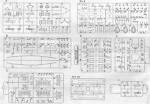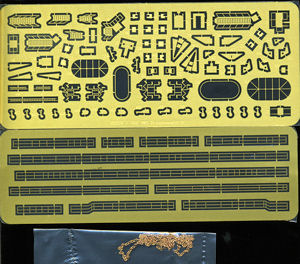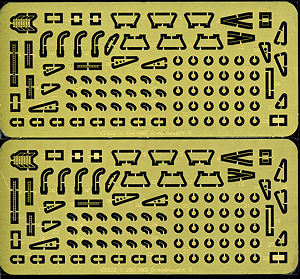
Trumpeter 1/350 HMS Dreadnought (1907)
| KIT #: | 05328 |
| PRICE: | $71.99 SRP |
| DECALS: | Four options |
| REVIEWER: | Scott Van Aken |
| NOTES: | New tool kit |

| HISTORY |
HMS Dreadnought was a battleship of the Royal Navy that revolutionised naval power. Her entry into service in 1906 represented such a marked advance in naval technology that her name came to be associated with an entire generation of battleships, the "dreadnoughts", as well as the class of ships named after her, while the generation of ships she made obsolete became known as "pre-dreadnoughts". She was the sixth ship of that name in the Royal Navy.
Admiral Sir John "Jacky" Fisher, First Sea Lord of the Board of Admiralty, is credited as the father of the Dreadnought. Shortly after he assumed office he ordered design studies for a battleship armed solely with 12-inch (305 mm) guns and a speed of 21 knots (39 km/h; 24 mph). He convened a "Committee on Designs" to evaluate the alternative designs and to assist in the detailed design process. One ancillary benefit of the Committee was that it would shield him, and the Admiralty, from political charges that they had not consulted leading experts before designing such a radically different battleship.
Dreadnought was the first battleship of her era to have a uniform main battery, rather than having a few large guns complemented by a heavy secondary battery of somewhat smaller guns. She was also the first capital ship to be powered by steam turbines, making her the fastest battleship in the world at the time of her completion. Her launch helped spark a major naval arms race as navies around the world, particularly the German Imperial Navy rushed to match her in the build-up to World War I.
Dreadnought did not participate in any of World War I's naval battles as she was being refitted during the Battle of Jutland in 1916. This was only time that British dreadnought battleships fired on their German counterparts during the war. However, she became the only battleship ever to sink a submarine when she rammed the SM U-29 when it unexpectedly broke the surface after firing a torpedo at another dreadnought in 1915. After Jutland, she was relegated to coast defence duties in the English Channel, only rejoining the Grand Fleet in 1918. She was reduced to reserve in 1919 and sold for scrap on 9 May 1921 for £44,000.
| THE KIT |
 Thanks to Trumpeter and others, we now have a growing collection of kits from WWI and earlier in modern injected plastic. This seems to be the growing trend with recent releases being ships of this type. Trumpeter has decided to do a kit of the battleship that changed the way capital ships were built, the HMS Dreadnought.
Thanks to Trumpeter and others, we now have a growing collection of kits from WWI and earlier in modern injected plastic. This seems to be the growing trend with recent releases being ships of this type. Trumpeter has decided to do a kit of the battleship that changed the way capital ships were built, the HMS Dreadnought.  T
T he kit includes a pair of photo etch frets and a section of copper chain for the anchor chains. You will notice that there are some railings included in the photo etch. These are for some of the superstructure decks and there is not enough to cover the circumference of the ship so that will need to come from another source. Other bits used in photo etch are some of the smaller braces for the masts and cross beams. Also included are bits for the ladders and gangways. Funnel screens are also part of the fit and a number of other small pieces that fit on the super structure including boat davits. There is a fret that is duplicated that has quite a few small circular bits that fit onto the deck itself as well as various hatches and bits for atop the guns. I have to say that this kit comes with a well detailed p.e. suite. Why they just did not go the additional step with more railings is a bit of a mystery, unless the ship never had them.
he kit includes a pair of photo etch frets and a section of copper chain for the anchor chains. You will notice that there are some railings included in the photo etch. These are for some of the superstructure decks and there is not enough to cover the circumference of the ship so that will need to come from another source. Other bits used in photo etch are some of the smaller braces for the masts and cross beams. Also included are bits for the ladders and gangways. Funnel screens are also part of the fit and a number of other small pieces that fit on the super structure including boat davits. There is a fret that is duplicated that has quite a few small circular bits that fit onto the deck itself as well as various hatches and bits for atop the guns. I have to say that this kit comes with a well detailed p.e. suite. Why they just did not go the additional step with more railings is a bit of a mystery, unless the ship never had them. | CONCLUSIONS |
| REFERENCES |
http://en.wikipedia.org/wiki/HMS_Dreadnought_%281906%29 November 2012 My thanks to Squadron Products for the preview kit. This one is available now at your local shop or on-line retailer. If you would like your product reviewed fairly and fairly quickly, please contact the editor or see other details in the Back to the Previews Index Page